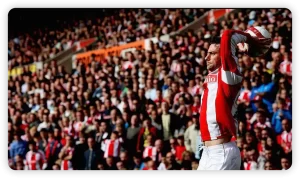The Unstoppable Weapon That Shook the Premier League
“Like a human sling,” marveled David Moyes. “The best Scud missile I’ve ever seen,” admitted Sam Allardyce, his tone laced with envy. For Luiz Felipe Scolari, Chelsea’s then-manager, Rory Delap’s long throws were beyond description: “I’ve never witnessed anything like this in my life.”
When Stoke City stormed into the Premier League in 2008, they brought with them a tactical anomaly that left even the most seasoned managers baffled. Delap’s javelin-like throws—flat, fast, and freakishly accurate—became the cornerstone of Stoke’s survival strategy, turning set-pieces into a legitimate scoring threat.

The Birth of a Tactical Masterstroke
From Training Ground to Premier League Dominance
Liam Lawrence, Stoke’s former winger, recalls the moment Delap’s talent was uncovered: “During a small-sided game, Rory took a throw-in that defied physics. The next day, Tony Pulis had him bombing balls into the box—and the rest is history.”
Delap’s background as a junior javelin thrower gave him an edge. His ability to hurl the ball 35+ yards with a laser-guided trajectory turned throw-ins into pseudo-corners. Pulis amplified this by narrowing the Britannia Stadium’s pitch to the league’s minimum width, ensuring Delap’s throws reached the six-yard box with alarming consistency.
The Science Behind the Chaos
Stoke’s set-piece routines were meticulously choreographed:
- Blocking schemes: Players like Ryan Shawcross used decoy runs, while teammates impeded markers.
- Carnage in the box: The chaos wasn’t accidental—it was engineered to disrupt defensive lines.
- Psychological warfare: Opponents dreaded Delap’s throws more than corners, with goalkeepers like Heurelho Gomes reportedly reduced to tears mid-game.
Stoke’s physicality and aerial dominance made them a nightmare for technical sides like Arsenal.
Arsenal’s Nemesis and the Tactical Arms Race
Wenger’s Frustration and the “Unfair Advantage” Debate
Arsène Wenger famously lobbied for rule changes after a 2-1 loss at the Britannia, where both Stoke goals originated from Delap’s throws. “It’s an unfair advantage,” he argued, even demanding restrictions on towel use to dry the ball.
Lawrence laughs at the memory: “Wenger tried everything—narrowing the pitch, banning towels. But we loved their frustration. It fueled us.” Stoke’s rivalry with Arsenal became symbolic of the clash between technical finesse and raw, physical pragmatism.
How Teams Adapted (or Failed To)
- Hull City’s desperation: Goalkeeper Boaz Myhill once conceded a corner rather than face another Delap throw.
- Defensive innovations: Some teams packed the six-yard box; others let keepers claim the ball. None found a perfect solution.
The Decline of a Tactical Era
Why Delap’s Throws Lost Their Edge
By 2011, opponents had adjusted. Stoke’s throw-in goals dropped from nine in 2008/09 to just four in 2010/11. Delap departed in 2013, and under Mark Hughes, Stoke pivoted to a more expansive style—sacrificing their identity for mid-table security.

The Legacy: Throw-Ins in the Modern Game
Today, set-piece specialists like Thomas Gronnemark are in demand, but no one has replicated Delap’s impact. As Lawrence notes, “Stoke’s identity was their strength. Lose that, and you lose everything.”
For Winbdt readers, Delap’s story is a reminder: In football, innovation isn’t always about beauty—sometimes, it’s about throwing convention out the window.
Want more tactical deep dives? Follow Winbdt for exclusive analyses on football’s most unconventional strategies!

